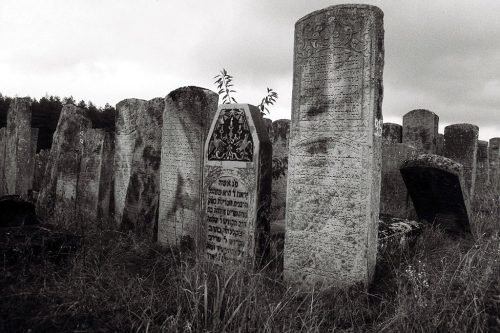Nash Holos: Brody Cemetary
 Brody is a city in western Ukraine, located in the the Lviv Oblast, or province, 90 kilometres northeast of Lviv. It is now the administrative center of the Brody Raion, or district, with a population of about 24,000.
Brody is a city in western Ukraine, located in the the Lviv Oblast, or province, 90 kilometres northeast of Lviv. It is now the administrative center of the Brody Raion, or district, with a population of about 24,000.
At one time, Brody was one of the greatest centers of commerce in Eastern Europe, outside of Lemberg, known today as Lviv. Brody was in fact once considered the continental version of the prosperous Mediterranean port of Triest.
Brody was also once known as the Galician Jerusalem. By the 19th century Brody had the highest concentration of Jews among Eastern European cities.
Today Jews all over the world can trace their roots to Brody. Many, upon emigration to new lands, adopted last names derived from Brody -- Brodsky, Brodowski, Brodovsky, Brodisch (meaning “from Brody”).
Brody’s recorded history dates back to the era of Volodomyr Monomakh in the 11th century. In the centuries following, Brody remained under Polish and Austrian control.
By the 17th century, Brody had become an important center of Jewish trade, known for its horse fairs and artisans -- cordmakers, weavers, and metalsmiths. In 1648 Brody was captured briefly by Ukrainian Cossack leader Bohdan Khmelnytsky. Notably its Jewish population was not harmed. Deemed as “not engaged in the maltreatment of Ruthenians” they were only required to pay a tribute in “textiles and furs.”
In 1772, Brody became a part of the Habsburg Empire. On a visit to Brody in 1774, Emperor Joseph II was rumoured to realize why one of the titles of Austrian emperors was “Jerusalem King.” In 1778, he issued a decree that launched an era of prosperity for Brody lasting 100 years.
With the partitions of Poland in the second half of the 18th century, new restrictive trade laws caused the decline of Jewish trade and rapidly rising poverty. As a transportation hub, Brody soon became over-run with emigrants bound for the New World. Brody was ill-equipped to handle this mass influx of refugees, so the emigration process took months and sometimes years.
The first world war and interwar periods brought much destruction to Brody, and World War two completely destroyed the Jewish community. Thousands of Brody’s Jews perished at the hands of the Nazis … either at gunpoint in Brody or in the Belzc and Majdanek concentration camps.
Brody has had three Jewish cemeteries. The site of the oldest one now has a warehouse on it. Another has become a football field in a residential neighborhood.
The newest Jewish cemetery is outside the town. It was built during a cholera epidemic and contains tombstones dating back to the early 19th century. These stones are unusually tall, some more than six feet. The cemetery and its stones have been threatened by erosion and vegetative overgrowth.
In 1996, Ukraine declared a moratorium on the privatization of sites identified as Jewish cemeteries. Construction is now banned at these sites.
In August of 2002, an American philanthropic organization provided funding for the clearing of vegetative overgrowth from the Brody cemetery. Meylakh Sheykhet, Executive Director of the Jewish Heritage Museum of L’viv, directed this undertaking. He discovered a larger area of the cemetery than was previously identified.
Additional projects of interest to Brody genealogists are also being undertaken. The newest is the documentation and photography of the approximately 5,000 tombstones in the Brody, Ukraine cemetery. The inscriptions will be translated and the data entered into Jewish databases that will be available free of charge to researchers.
Listen to the program here.
Ukrainian Jewish Heritage is brought to you by the Ukrainian Jewish Encounter (UJE), a privately funded multinational organization whose goal is to promote mutual understanding between Ukrainians and Jews. Transcripts and audio files of this and earlier broadcasts of Ukrainian Jewish Heritage are available at the UJE website and the Nash Holos website.



















